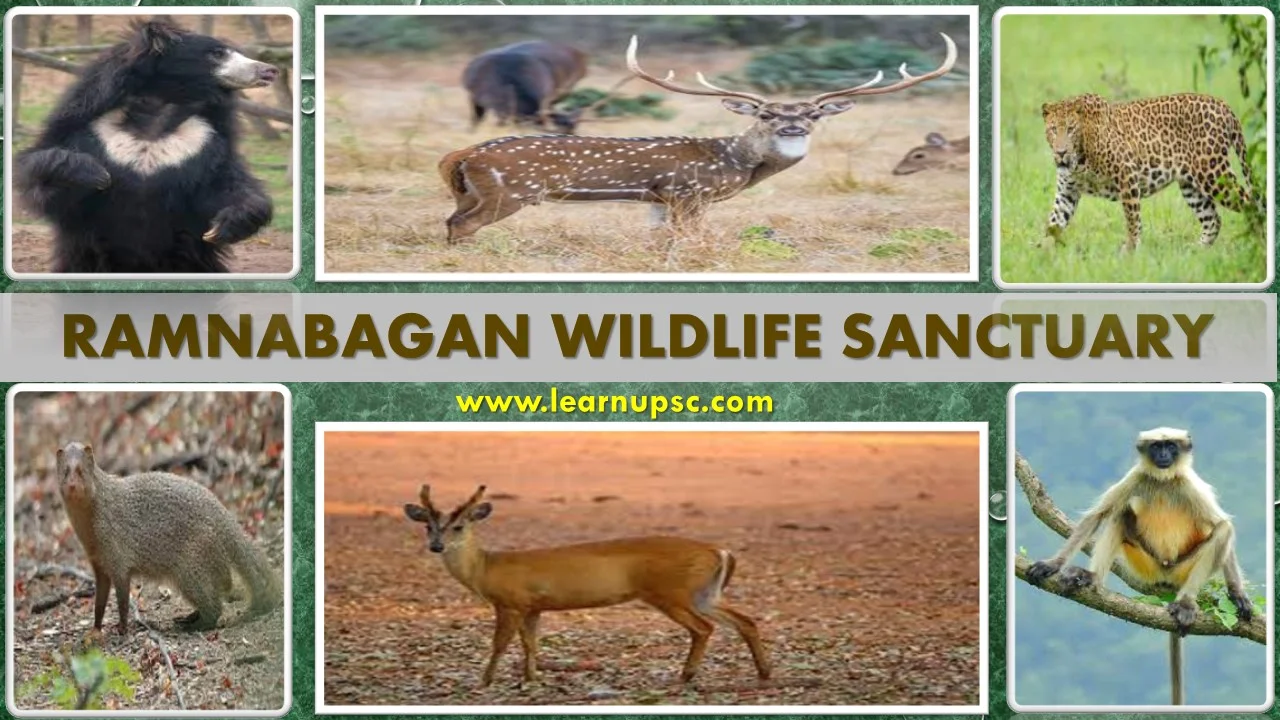Ramnabagan Wildlife Sanctuary UPSC
The Ramnabagan Wildlife Sanctuary is situated in the state of West Bengal, India. The sanctuary features a tropical deciduous forest.
The area was declared a reserved forest in 1960 and later converted into a deer park in 1978 with the introduction of spotted deer. Subsequently, the entire area was declared a wildlife sanctuary.
A mini zoo within the sanctuary, now known as the Bardhaman Zoological Park, was approved by the Central Zoo Authority.
The best time to visit the sanctuary is from October to March.
|
Table of Contents
|
Ramnabagan Wildlife Sanctuary Location
The Ramnabagan Wildlife Sanctuary is located within the municipal limits of Burdwan (Bardhaman) in the Indian state of West Bengal.
Ramnabagan Wildlife Sanctuary Nearest Airport:
The nearest airport to Ramnabagan Wildlife Sanctuary is the Netaji Subhas Chandra Bose International Airport, which is located approximately 200 kilometers away in Kolkata, West Bengal, India.
Ramnabagan Wildlife Sanctuary Nearest Railway Station:
The nearest railway station to Ramnabagan Wildlife Sanctuary is the Burdwan Railway Station, which is conveniently located just 4 kilometers from the sanctuary.
Ramnabagan Wildlife Sanctuary History
The Ramnabagan Wildlife Sanctuary has a history that includes its development from a reserved forest to a wildlife sanctuary and the establishment of a mini zoo within its boundaries. Here's a brief overview of its history:
Reserved Forest: The area that would later become the Ramnabagan Wildlife Sanctuary was initially declared a reserved forest in 1960. Reserved forests are protected areas designated for the conservation of flora and fauna.
Deer Park: In 1978, a significant development took place when the area was converted into a deer park. At this time, six spotted deer were introduced to the area. The introduction of these deer marked the beginning of the sanctuary's role in wildlife conservation and recreational activities.
Wildlife Sanctuary: Subsequently, the entire area was declared a wildlife sanctuary in 1981. This step formalized the conservation efforts in the region and expanded the scope beyond just a deer park.
Mini Zoo (Later Renamed Bardhaman Zoological Park): Within the Ramnabagan Wildlife Sanctuary, a mini zoo was established. Over time, this zoo was renamed as the Bardhaman Zoological Park. This mini zoo within the sanctuary allows for the care and display of various animal species, including those not typically found in the wild in the area.
Recent Developments: In recent years, the Bardhaman Zoological Park (formerly Ramnabagan Mini Zoo) has seen developments, including the construction of new, spacious enclosures for animals and the establishment of a Nature Interpretation Centre for educational purposes, particularly for children.
Ramnabagan Wildlife Sanctuary Area
The Ramnabagan Wildlife Sanctuary covers an area of approximately 0.14 square kilometers (14.31 hectares). This sanctuary plays an essential role in the conservation of local flora and fauna, as well as providing a space for education and recreation.
Ramnabagan Wildlife Sanctuary Flora
The Ramnabagan Wildlife Sanctuary is characterized by a tropical deciduous forest habitat with a variety of flora. Here are some of the key plant species that can be found in the sanctuary:
Teak (Tectona grandis): Teak is a prominent tree species in the sanctuary and is known for its high-quality timber.
Sal (Shorea robusta): Sal trees are another dominant species in the forest. They are important for their timber and provide habitat for various wildlife.
Kadbels (Limonia acidissima): Kadbels, also known as wood apple or elephant apple, are mesophytic plants found in the sanctuary.
Dumur (Ficus racemosa): Dumur, also known as the cluster fig tree, is another mesophytic species present in the area.
Jam (Syzygium cumini): Jam trees, also known as Java plum or Indian blackberry, are part of the mesophytic flora found in the sanctuary.
Bamboo: Bamboo plants are known to do exceptionally well in the sanctuary, and bamboo groves can be found in the area.
Ramnabagan Wildlife Sanctuary Fauna (Ramnabagan Wildlife Sanctuary Animals)
The Ramnabagan Wildlife Sanctuary is home to a variety of fauna, including mammals, birds, and reptiles. Here are some of the notable wildlife species that can be found in the sanctuary:
Mammals:
- Leopard
- Sloth Bear
- Spotted Deer
- Barking Deer
- Sambar Deer
- Mongooses
- Grey Langur
Birds:
- Peafowl
- Spotted Dove
- Adjutant Stork
- Rosy Pelican
- Parakits
- Cuckoos
- Storks
- Owls
Reptiles:
- Snakes
- Saltwater Crocodile
- Box Turtle
- Star Turtle
Ramnabagan Wildlife Sanctuary UPSC Questions
Q. Where is Ramnabagan Wildlife Sanctuary?
A. The Ramnabagan Wildlife Sanctuary is located in Purba Bardhaman district of West Bengal, India.


No comments:
Post a Comment